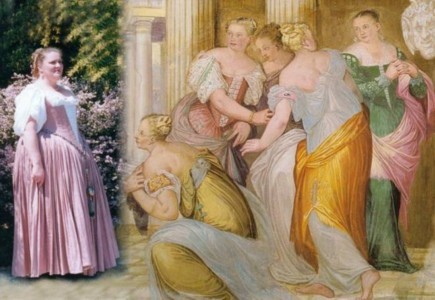
Venetian Dress
My First Steps

The Venetian woman, was a well fleshed woman as was the ideal for beauty of the time. If you had money and position you could afford to eat, and eat well. The classic Venetian silhouette is one of a full figured woman; full hips yet not unnaturally full and a rounded torso reshaped by a corset.
There is an ongoing discussion as to wether or not pink is an appropriate colour for renaissance dress. The pictorial evidence would suggest that it is. As to dyeing methods. Pink is just a pale red, and red was a highly sort after dye.
So I have put together a list of images that show Venetian women wearing Pink I host in my pages.
|
|
The
Malcontenta. In Context it is a fresco to the left of a bed.
La
Malcontenta fresco. 1549 – 63 The frescos are attributed to
Giovanni Battista Zelotti and Battista Franco. Villa Foscari, better
know as La Malcontenta, near the coastal lagoon of Venice. |
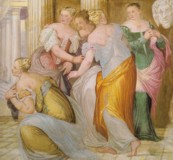 |
Sopohonisba, pleading with Massinissa, detail, Fresco Giovanni Antonio Fasolo, c1560 Villa Da Porto Colleona, Thiene, Vicenza |
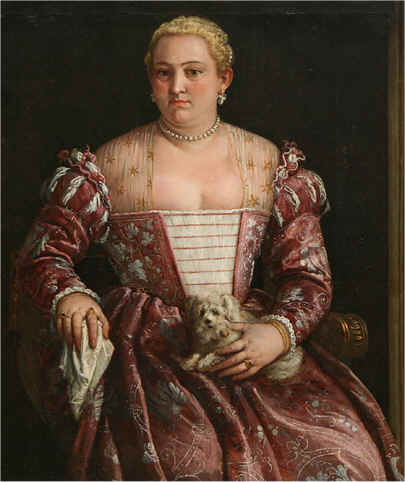 |
Portrait of a Woman Oil on canvas; 46 3-4 x 39 in. (118.7 x 99.1 cm), including added strip of 5 1-2 in (14 cm) at top undated The Metropolitan Museum of Art New York |
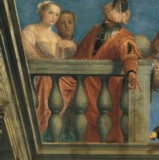 |
Detail: Feast In The House Of Simon 1556-60 Veronese |
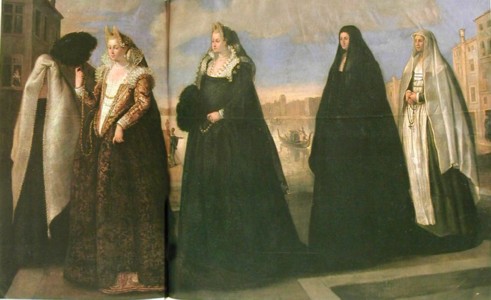 |
Dame_ |
 |
Arrival of
Henri III at the Lido in 1574, detail
Andrea Michieli il Vicentino, Museo Correr, Venice |
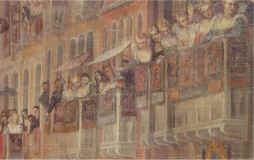 |
The Arrival of Henry III at
Palazzo Foscare detail
Staatliche Kunstsammlungen Gemaldegaleris Altemeister Woman in the middle under the white awning. |
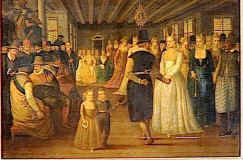 |
A ball scene the details of which I am unsure of at the moment. |
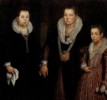 |
Ritratto di gentildonne della famiglia Giusti del Giardino: Girolamo Forni, olio su tela, 129 x 135 cm Private Collection |
 |
Solome Attributed to Titian Date and location unknown |
 |
Attributed
to Titian, Date and locations unknown.
|
The Pink Venetian dress in the photo has 10 metres of fabric 112cm wide, in it. These girls knew how to be decadent. The pink is 100% cotton damask in a pattern I have never seen before or since. The pink was such a find, and at $4.99 aust per metre a thing not to be passed up.
I was lucky enough to find that the material I used, a damask, for this dress is very similar in design to historical textiles of the time.
As this was my very first Venetian frock I didn’t make this frock with the V back that is one of the characteristics of Venetian dress not seen elsewhere, (I’d save that for another frock). The waist at the front have a very noticeable V shape, this holds its shape partially supported by boning in the bodice. This boning also helps to hold the shape of the bodice under the strain of the ladder lacing, as did the canvas interfacing and the linen lining. With out the boning the lacing would cause the bodice to crumple at the opening. The lacing is done through small brass rings sewn in just under the opening so that they oppose each other rather than being off set, this is because the dress is ladder laced. This article, The Zen of Spiral Lacing explains it very nicely and has wonderful illustrations.
The shoulder straps are very wide set so as to almost disappear off the shoulders. This also restricts the range of movement of the arms; reaching forward isn’t a comfortable operation. The torso has unnatural shaping; being flattened into a barrel shape with no curvature under the breasts as we would expect to see today. This is attributable to the wearing of a corset.
The skirt was cut so that the waist tapered from what would be the side of the dress to the centre front point. This was because of the cut of the bodice, which the skirt would be directly sewn into. Once the taper was cut a wide bias strip was sewn into the waist of the skirt and turned to the wrong side of the skirt for cartridge pleating. Underskirts were like wise used to add fullness to the hips, unlike the Elizabethans who used bum rolls to add fullness.
The fresco,
which inspired this frock, did not show the wearer as having sleeves; fair
enough, it would seem to be a logical thing for hot weather. As this frock was made for our Valentines feast, and one of
the hottest events of the year, so to go sans sleeves seemed more than
reasonable to me. The waist is
finished with a beaded girdle and my
hair is dressed with fresh water pearls and
‘borrowed’ hair, (lots of braided hair pieces I use for that ‘I’ve spent
hours having my hair done’ look).
A casual stroll around the garden on a cool spring afternoon. Who Said the historical dress wasn't in fashionable colours? Pink and Green are this seasons (summer 2004-5) fashion colours in the real world.
Putting Yourself In The Picture
All intellectual content, composition, layout, designs and photographs, unless otherwise noted are copyright 2007 to Deborah Lane ©, or, copyright 2003 to Deborah Murray © also known as Mistress Oonagh O'Neill ©. All Original renaissance art works and artefacts are not copyright to Deborah Murray, and are shown for educational use only . If you see something you'd really like to use, please contact me!